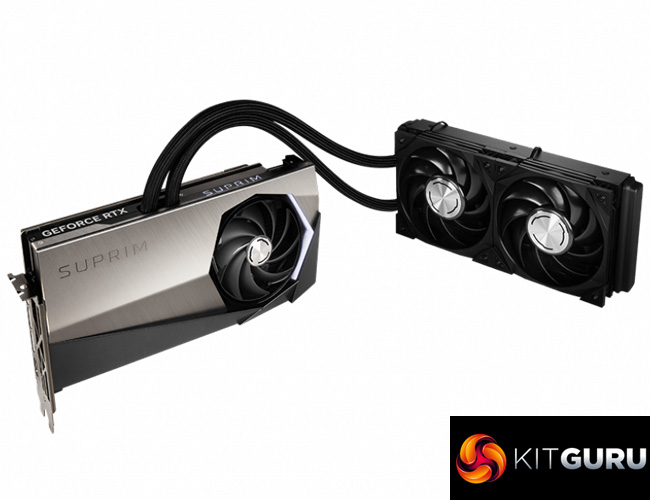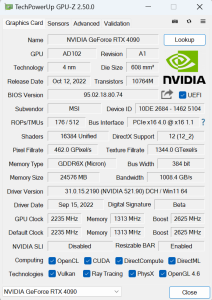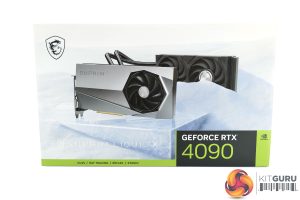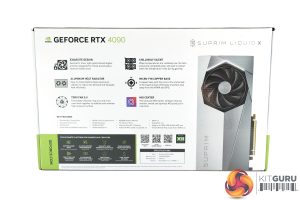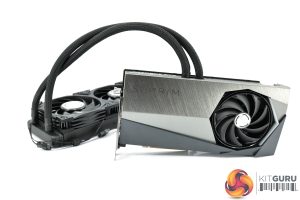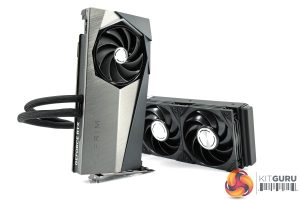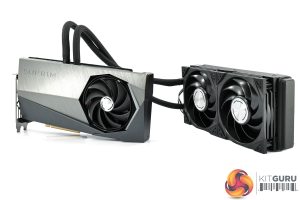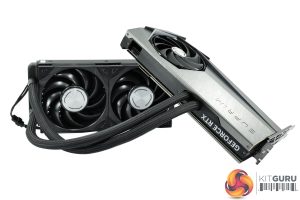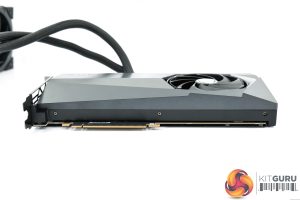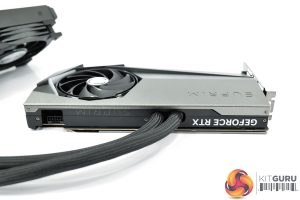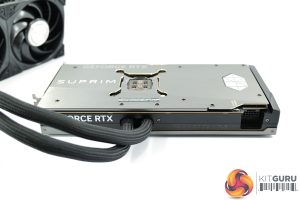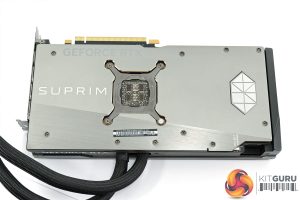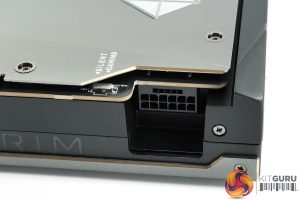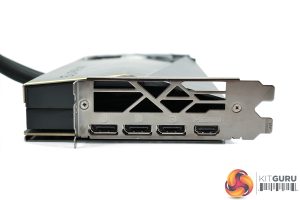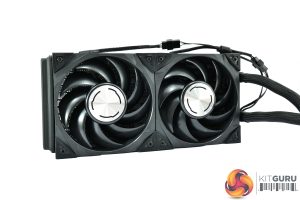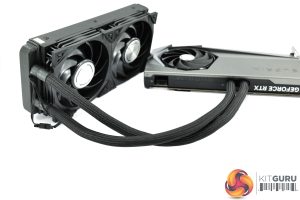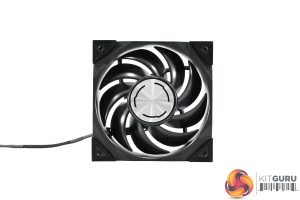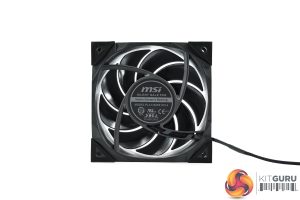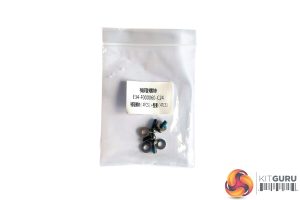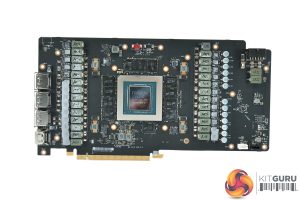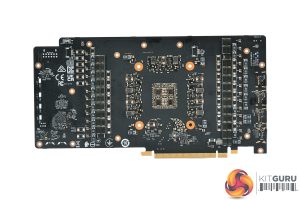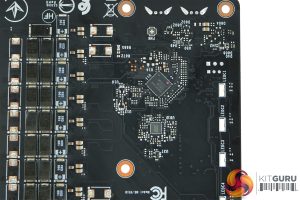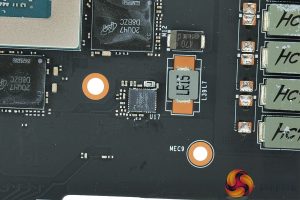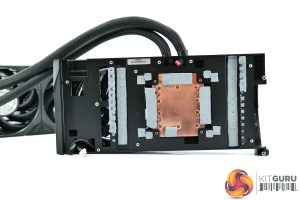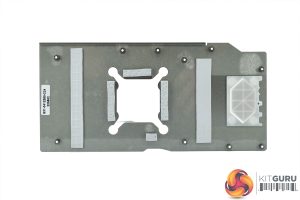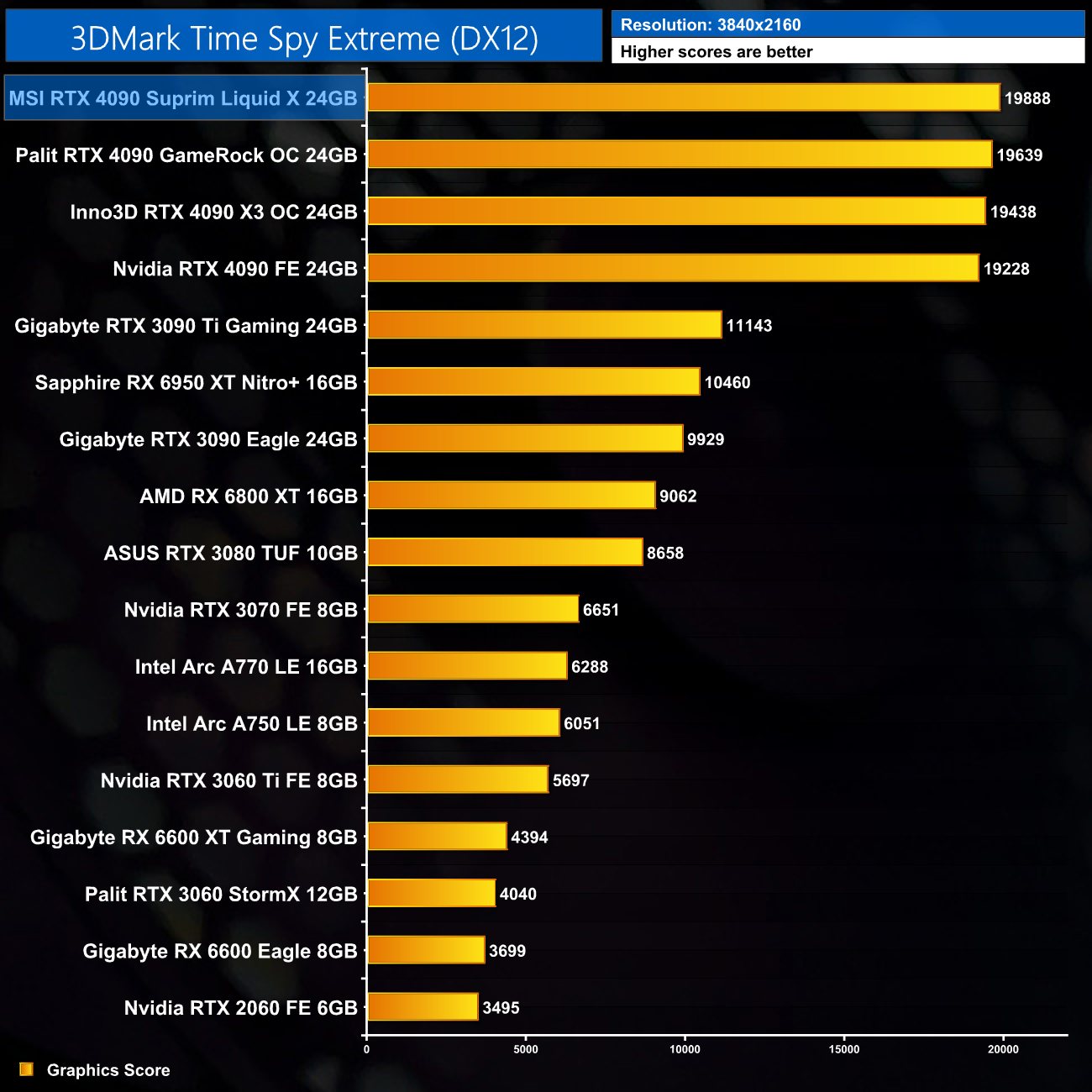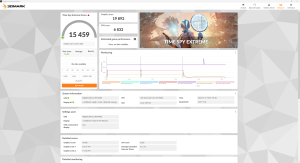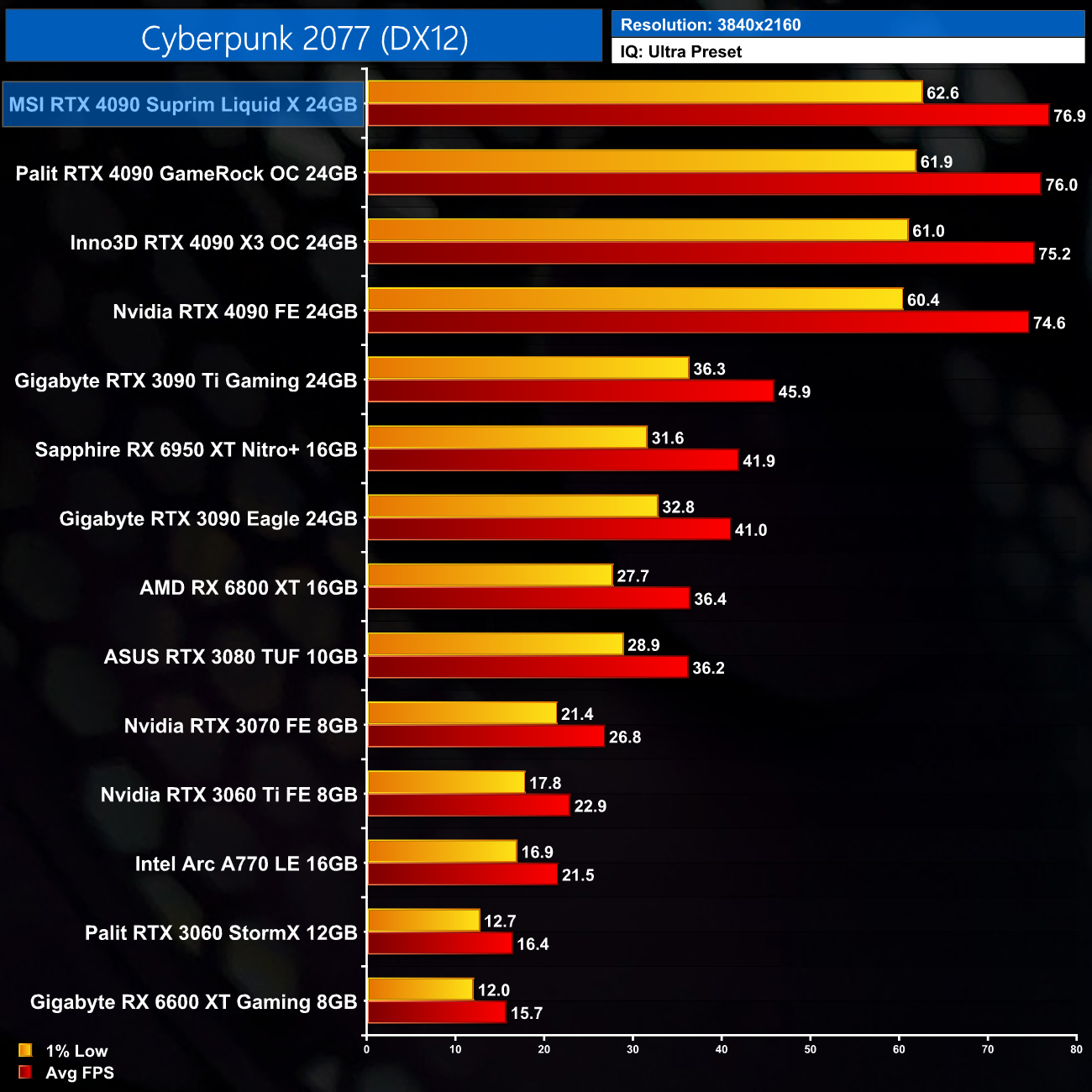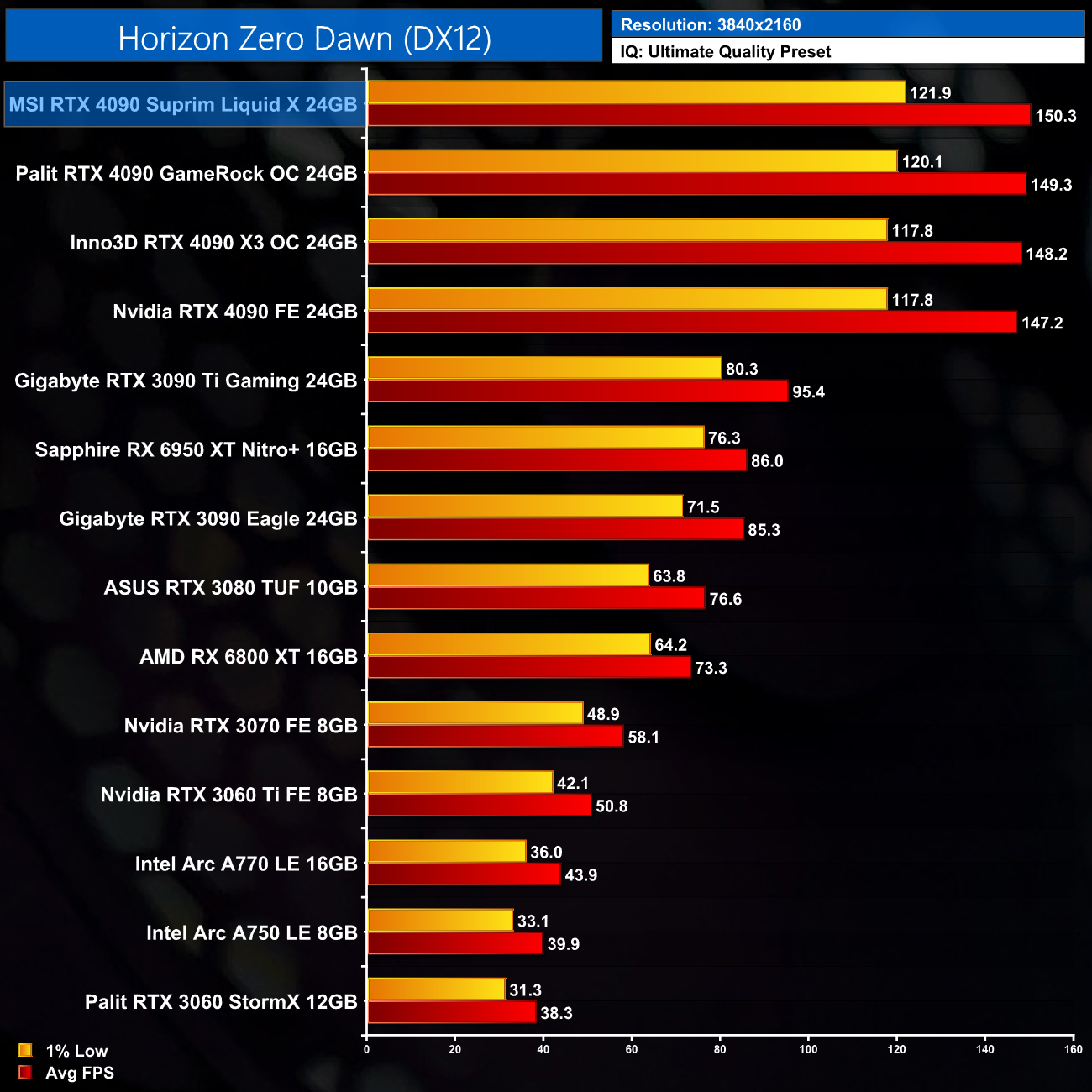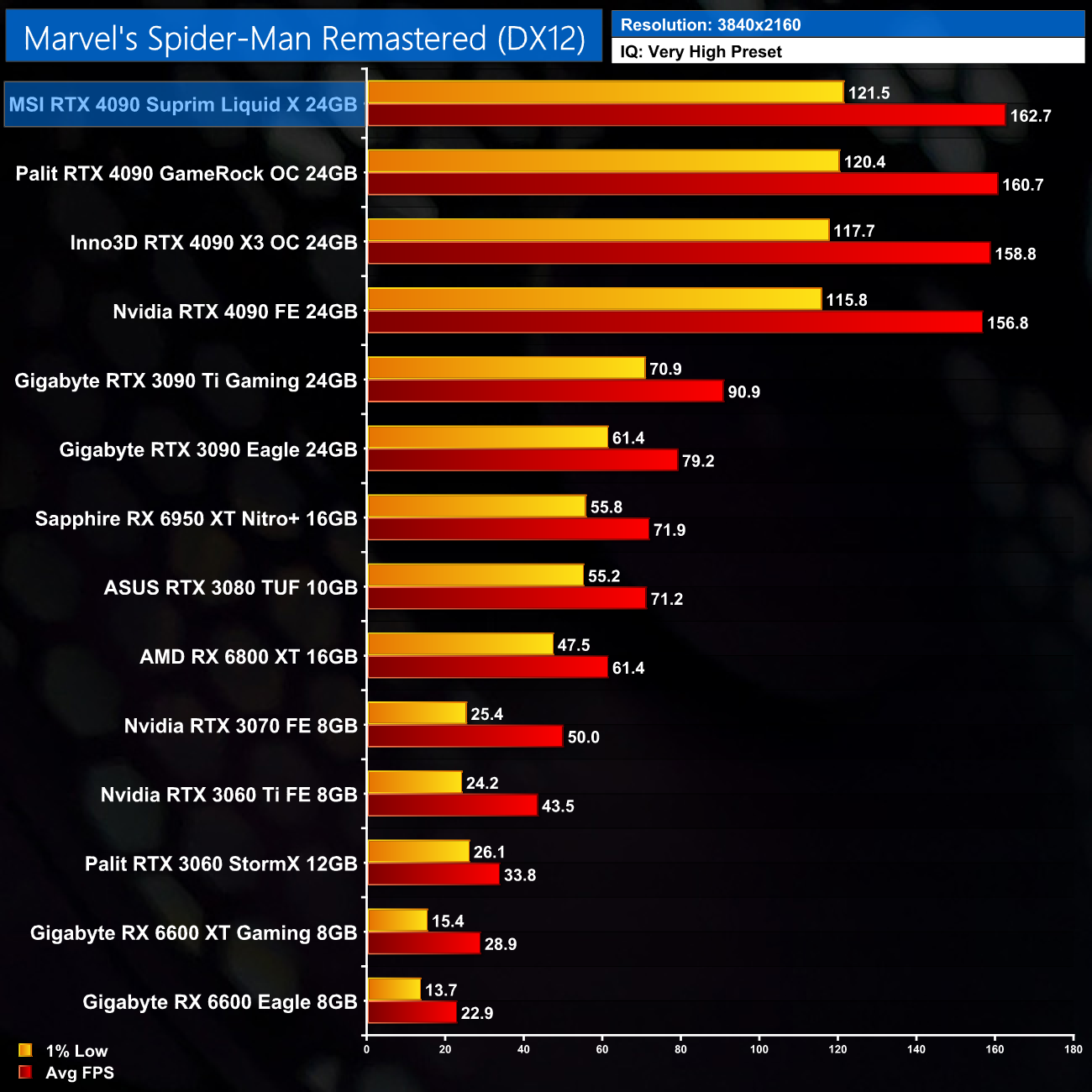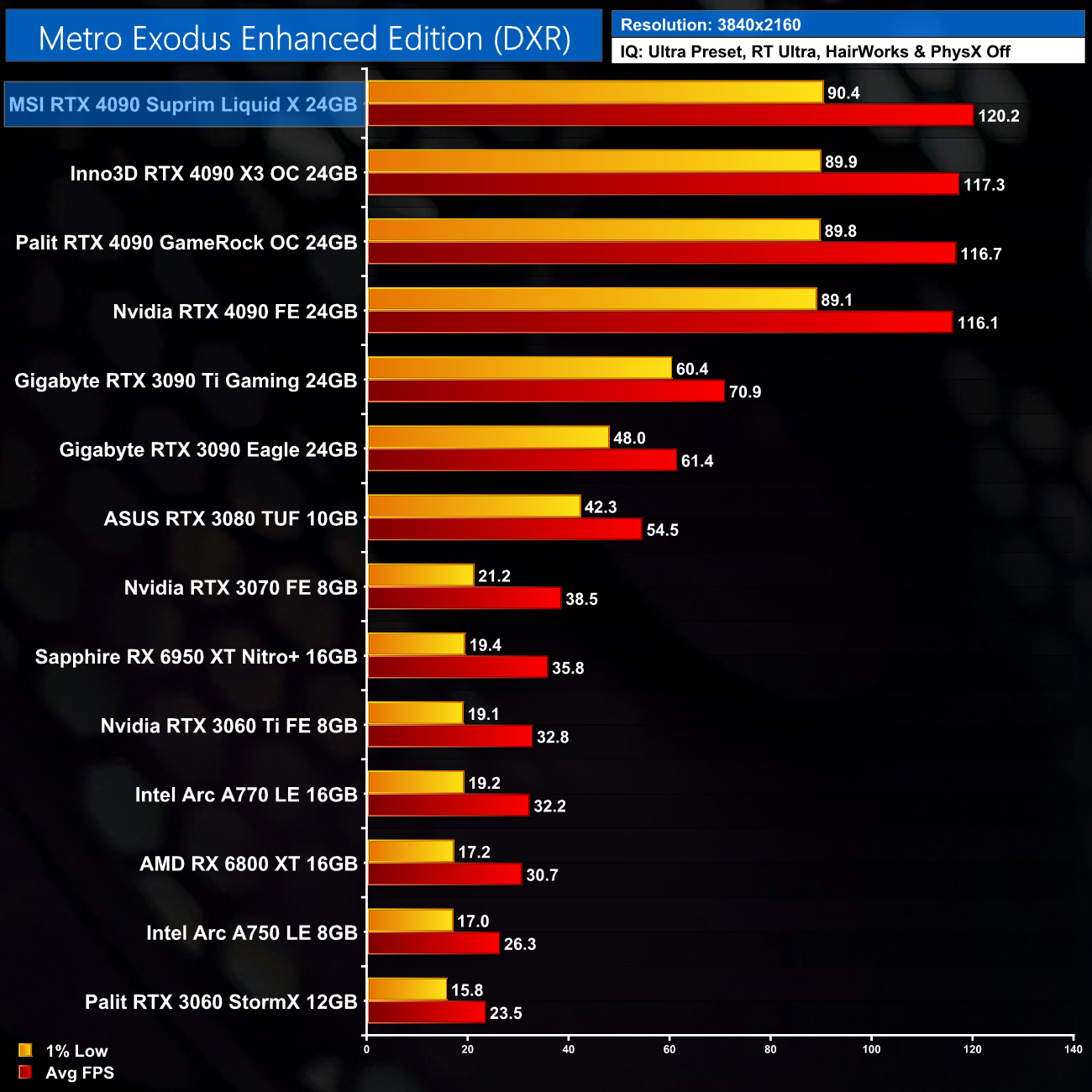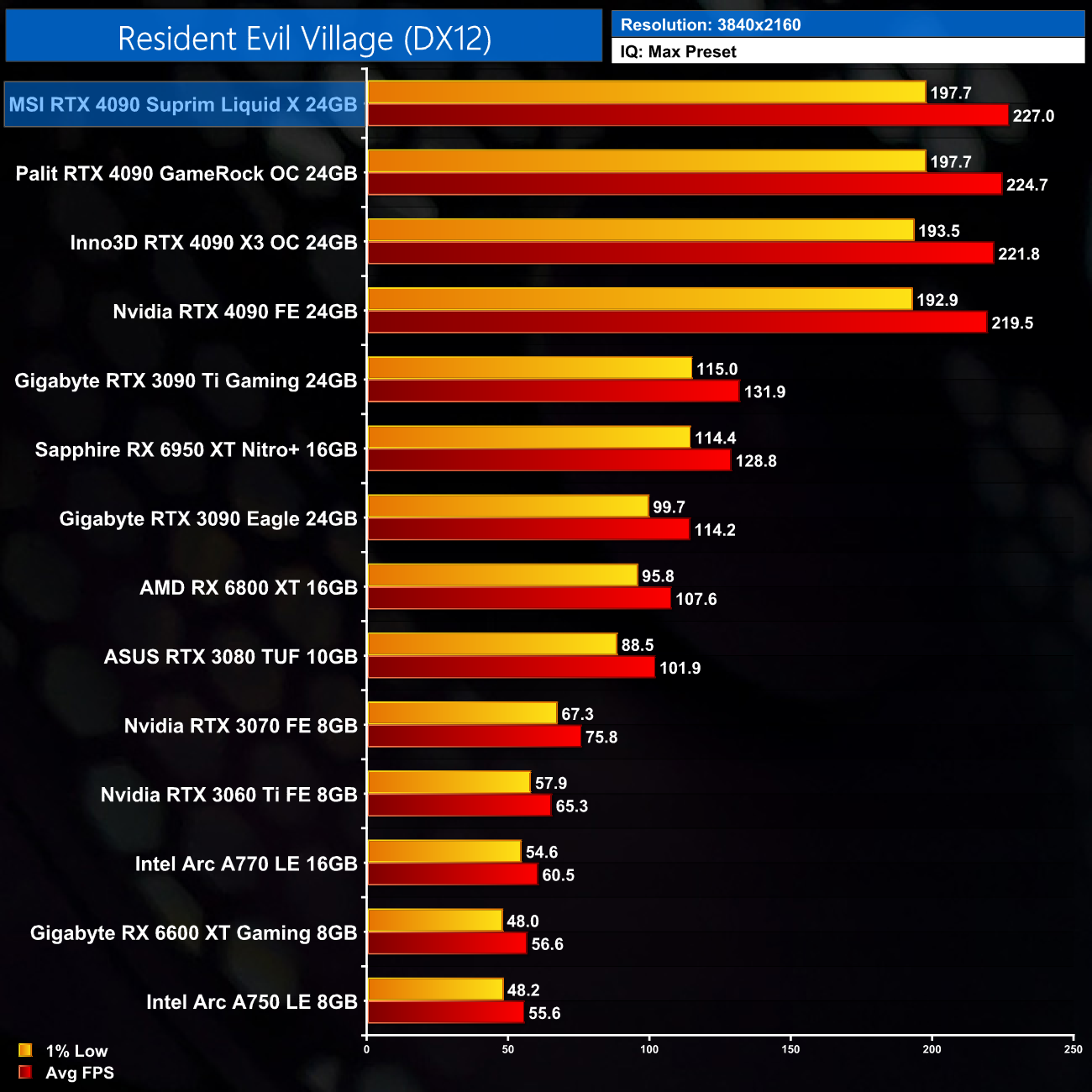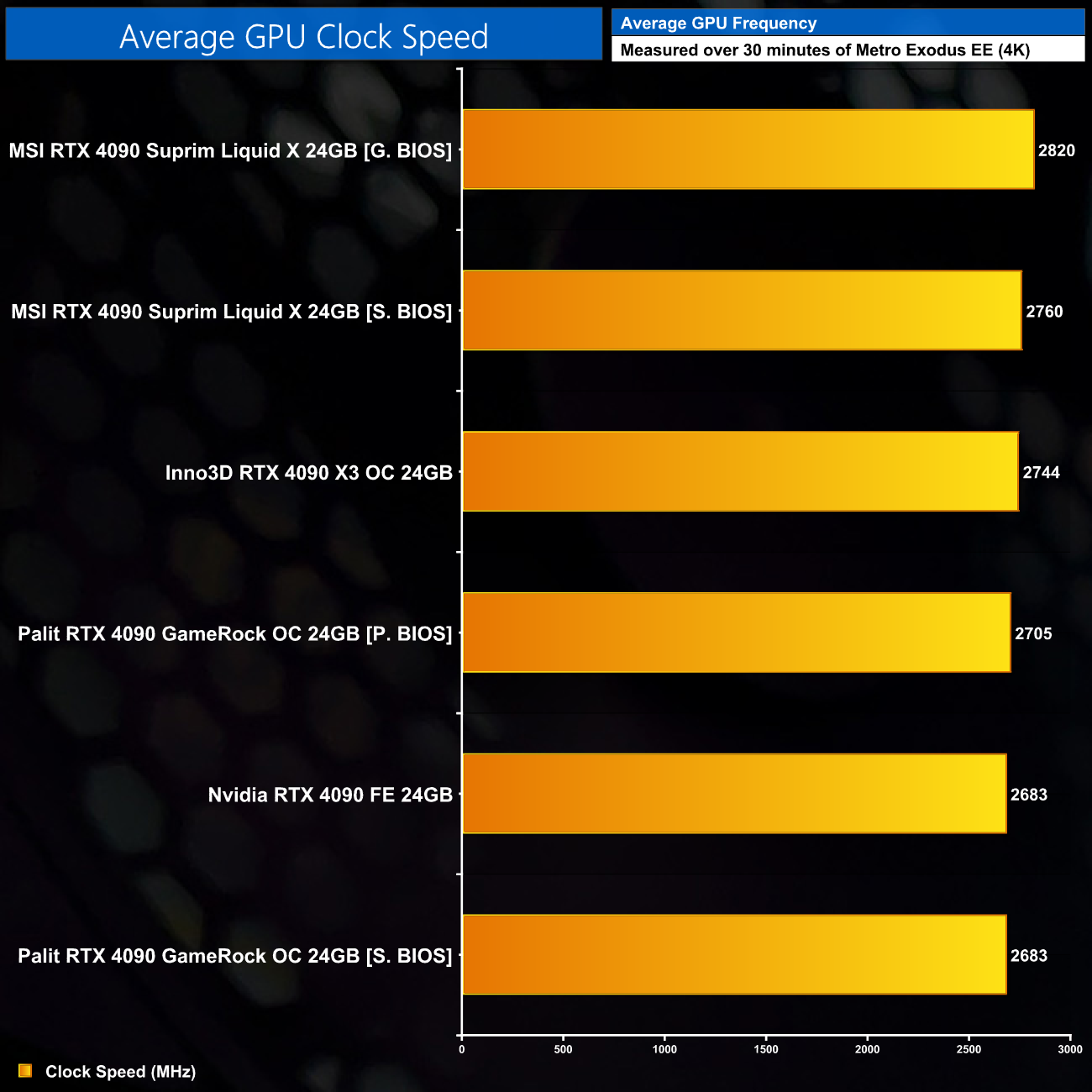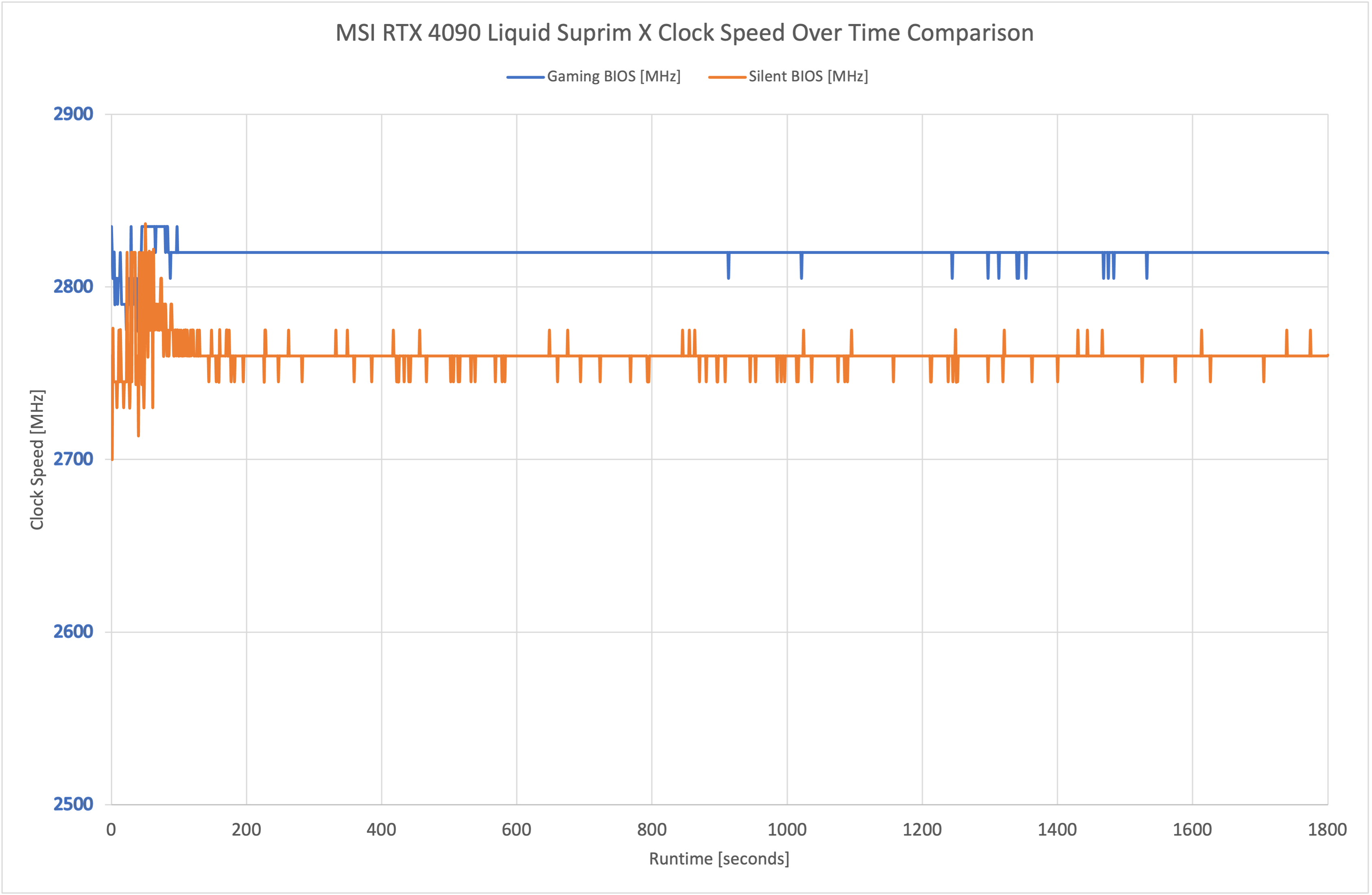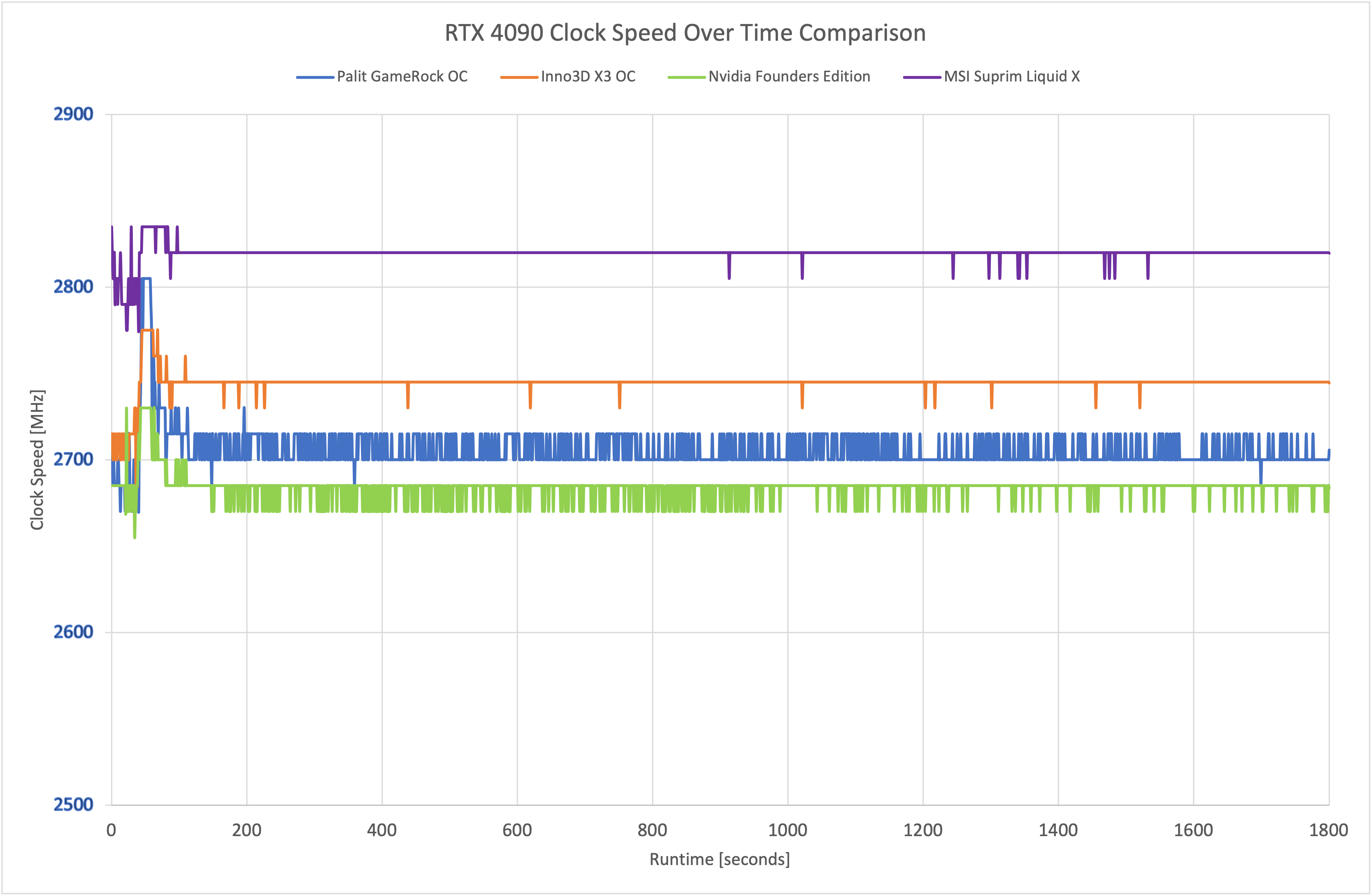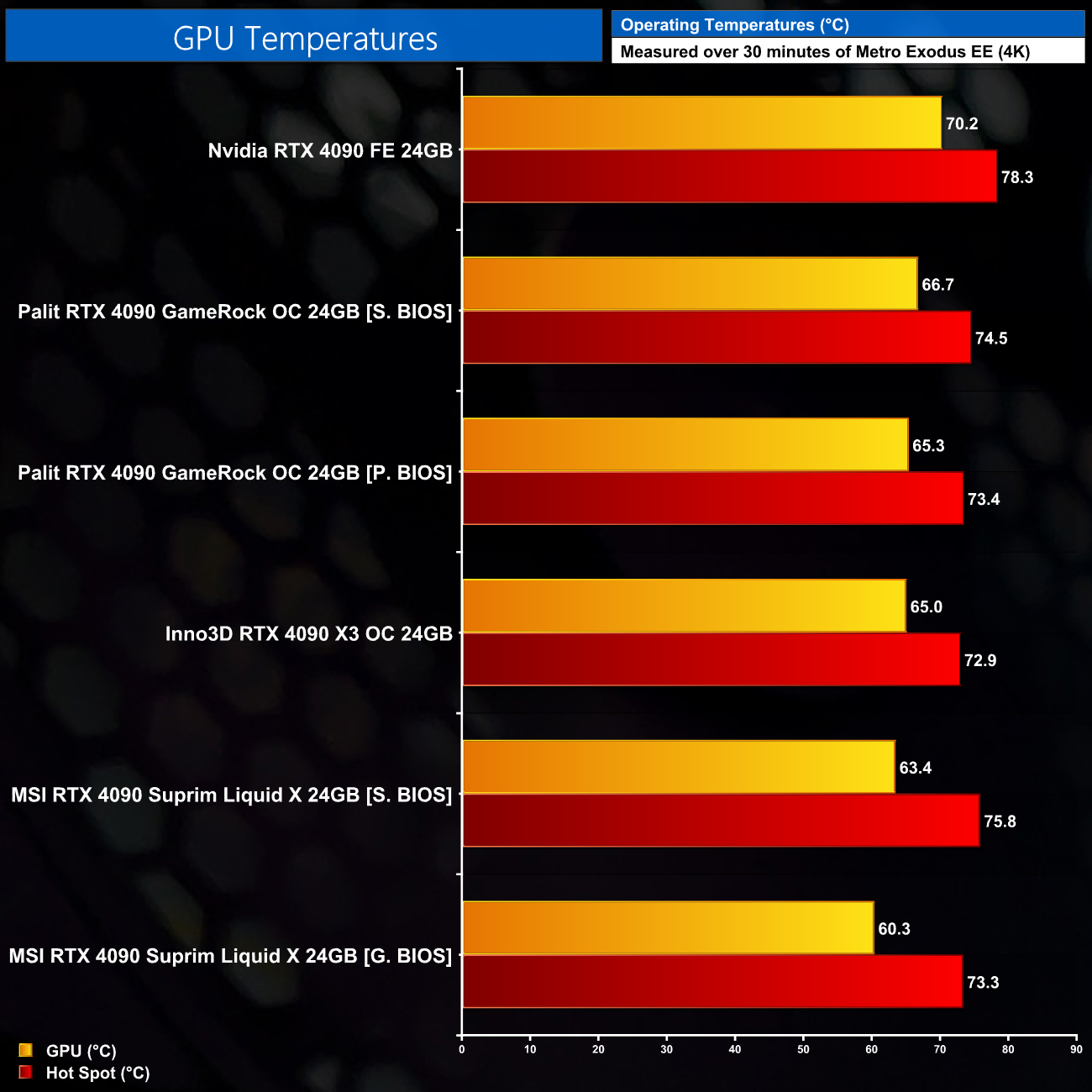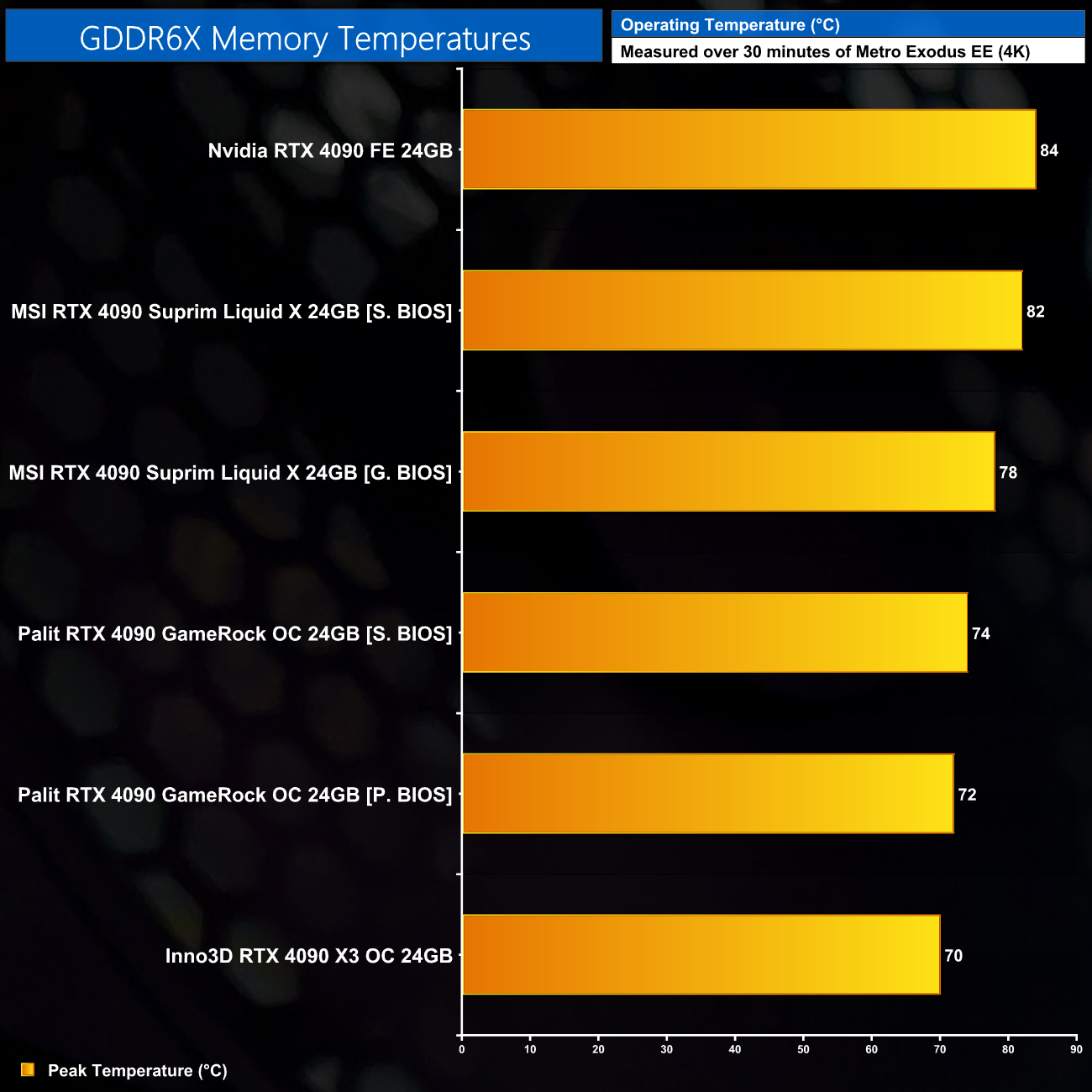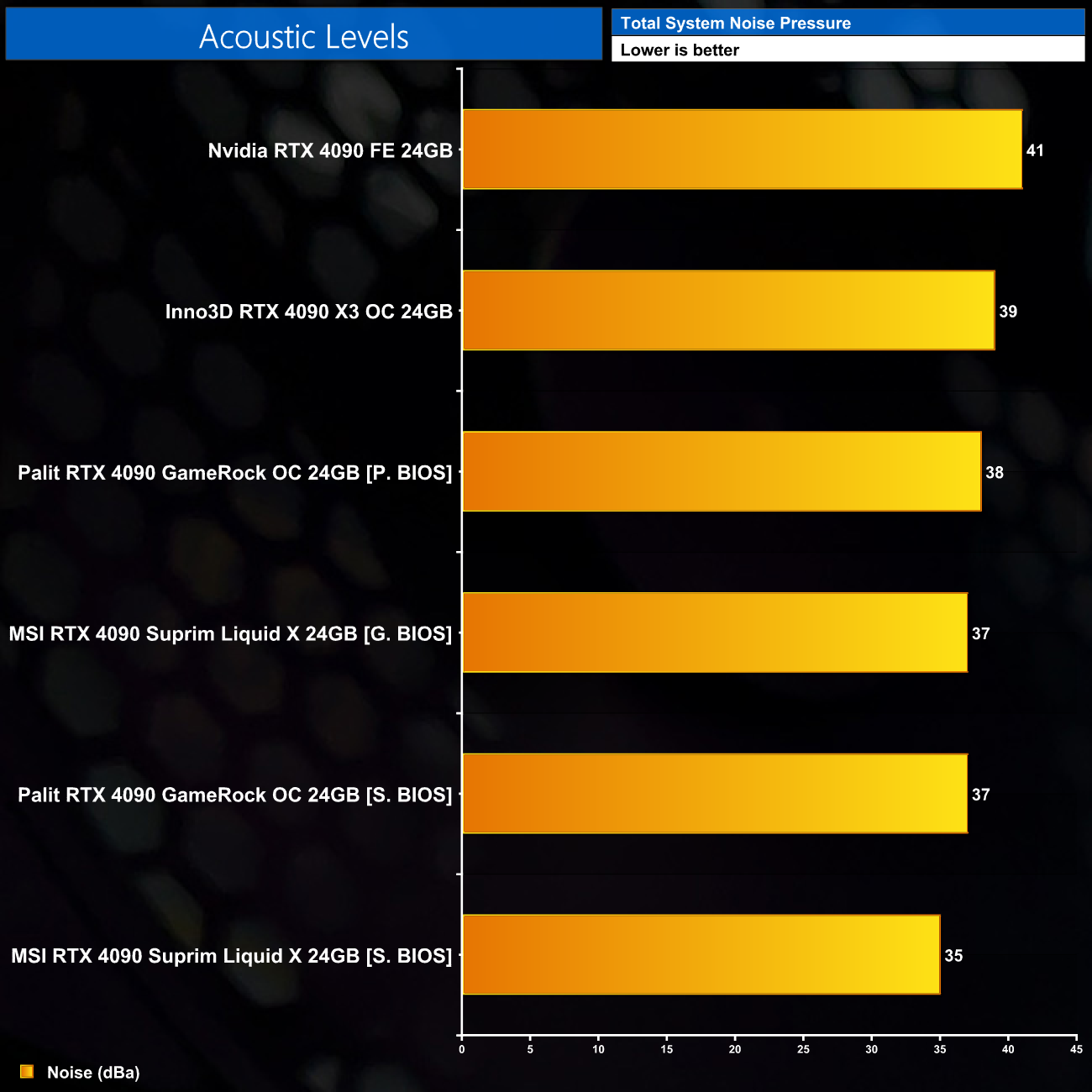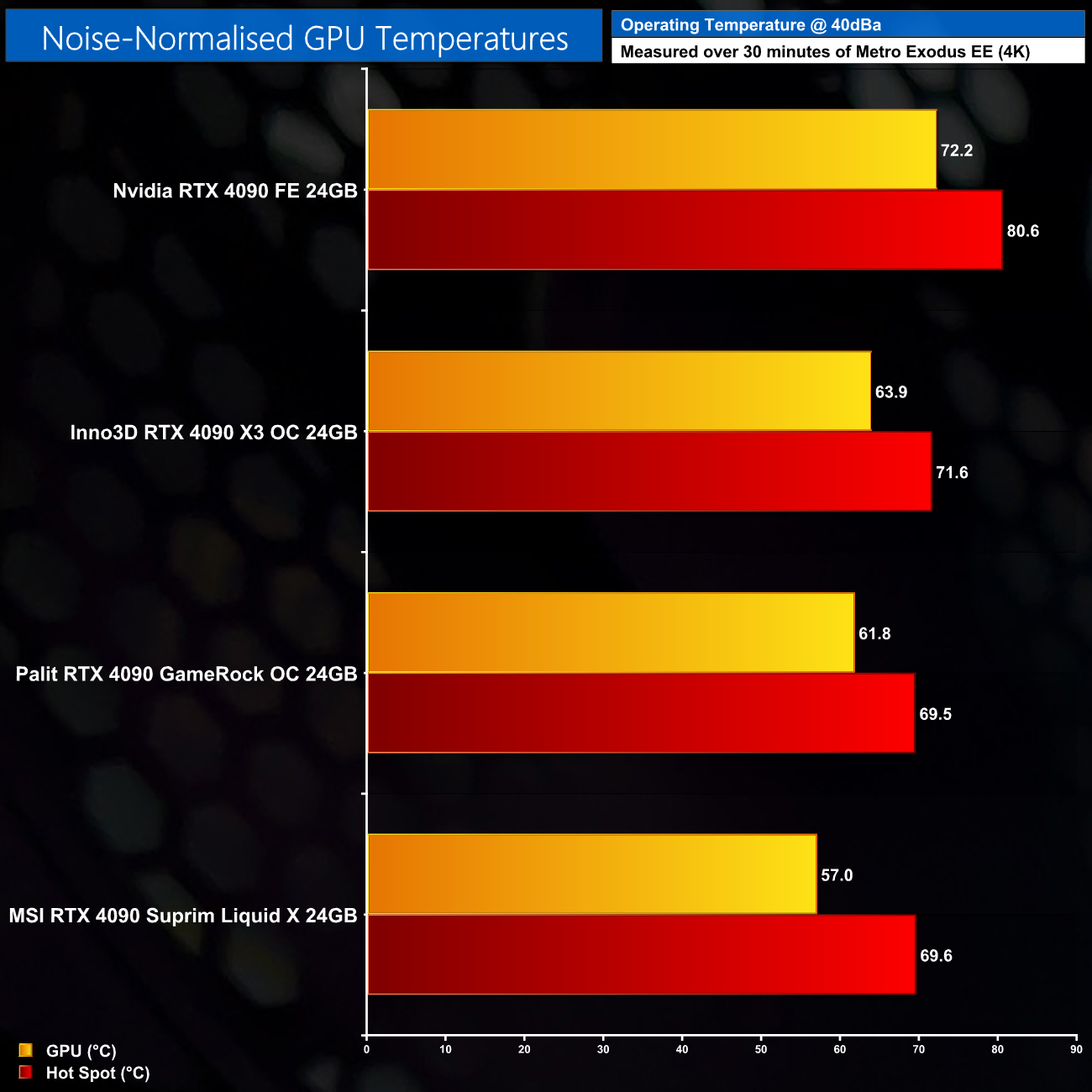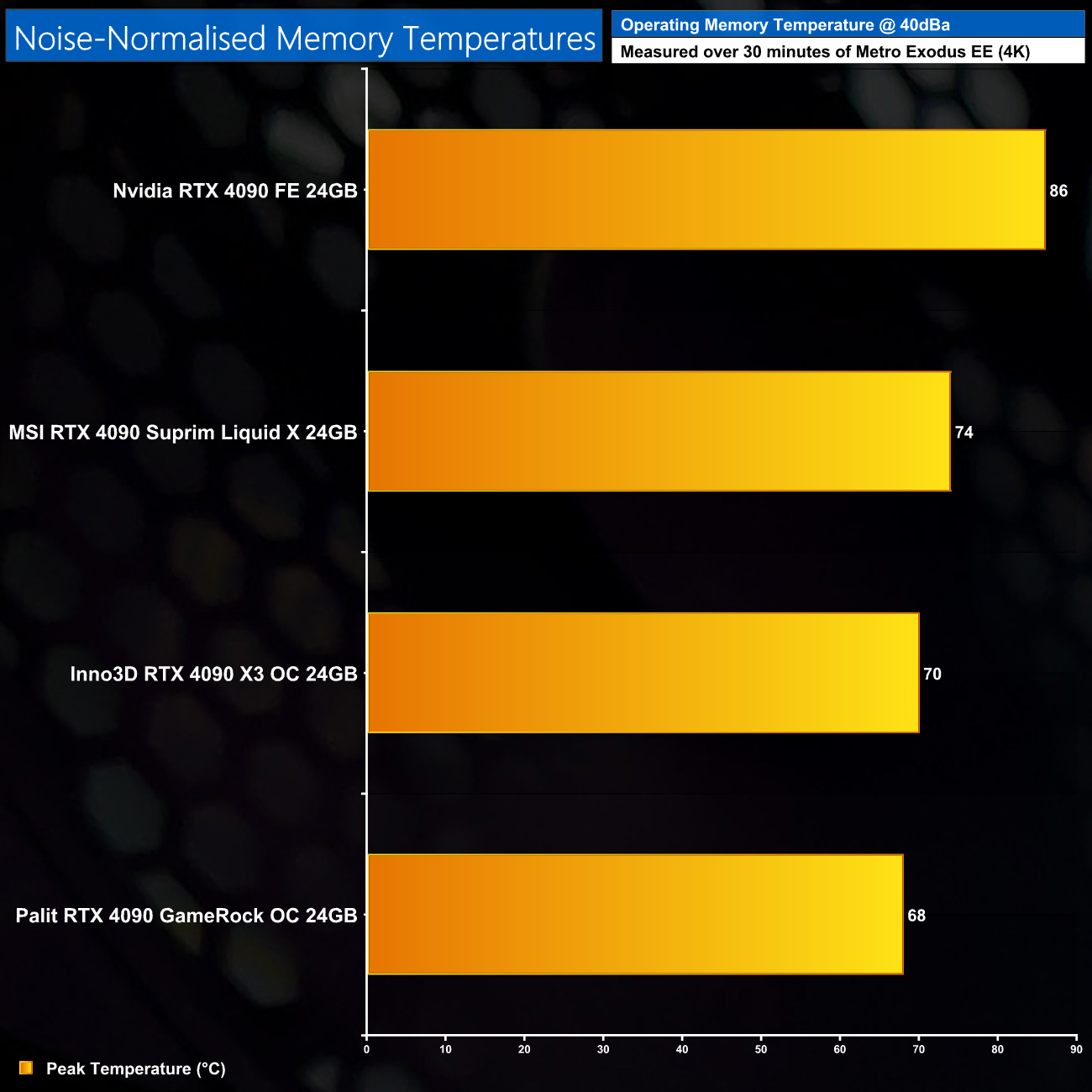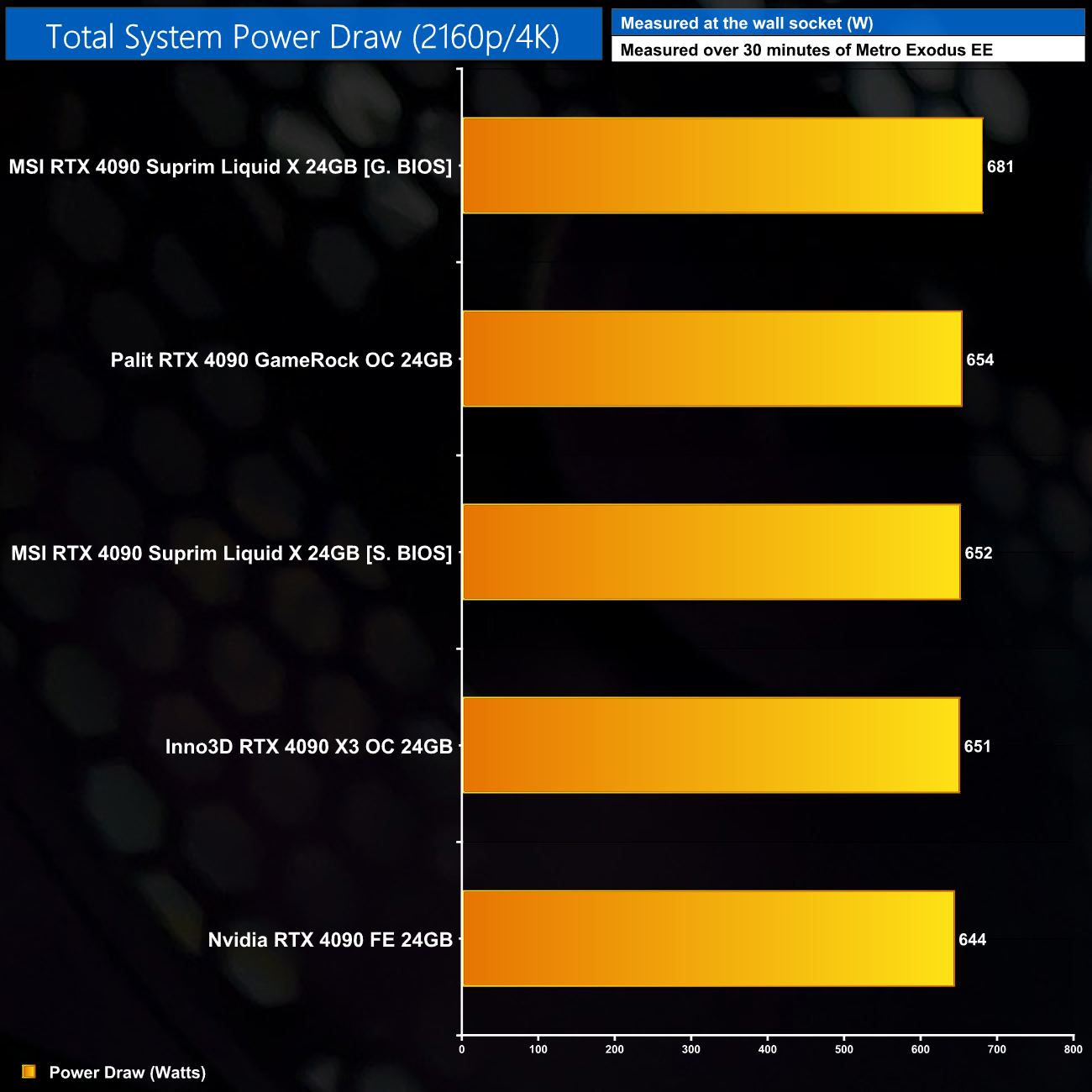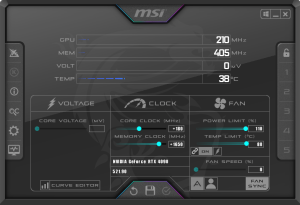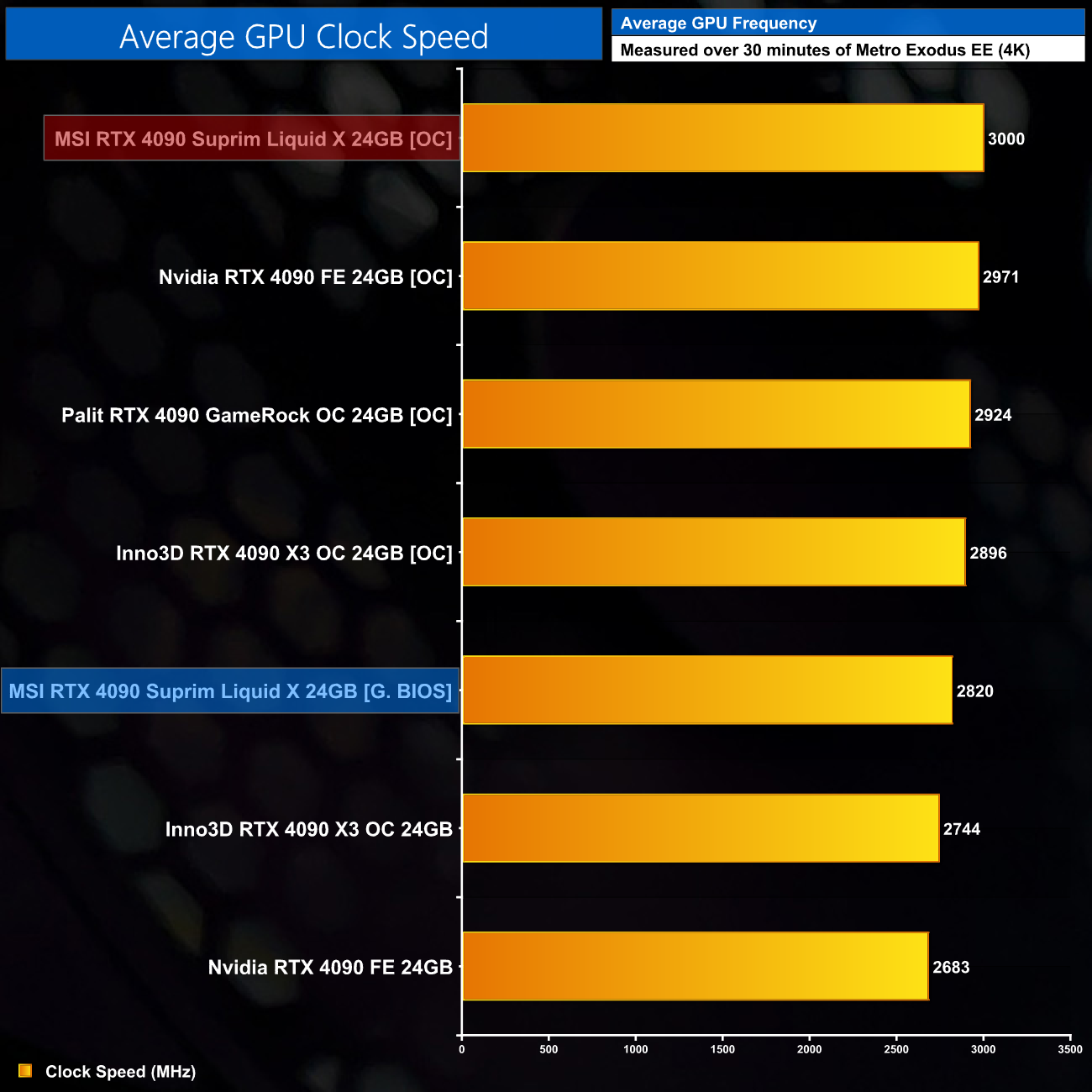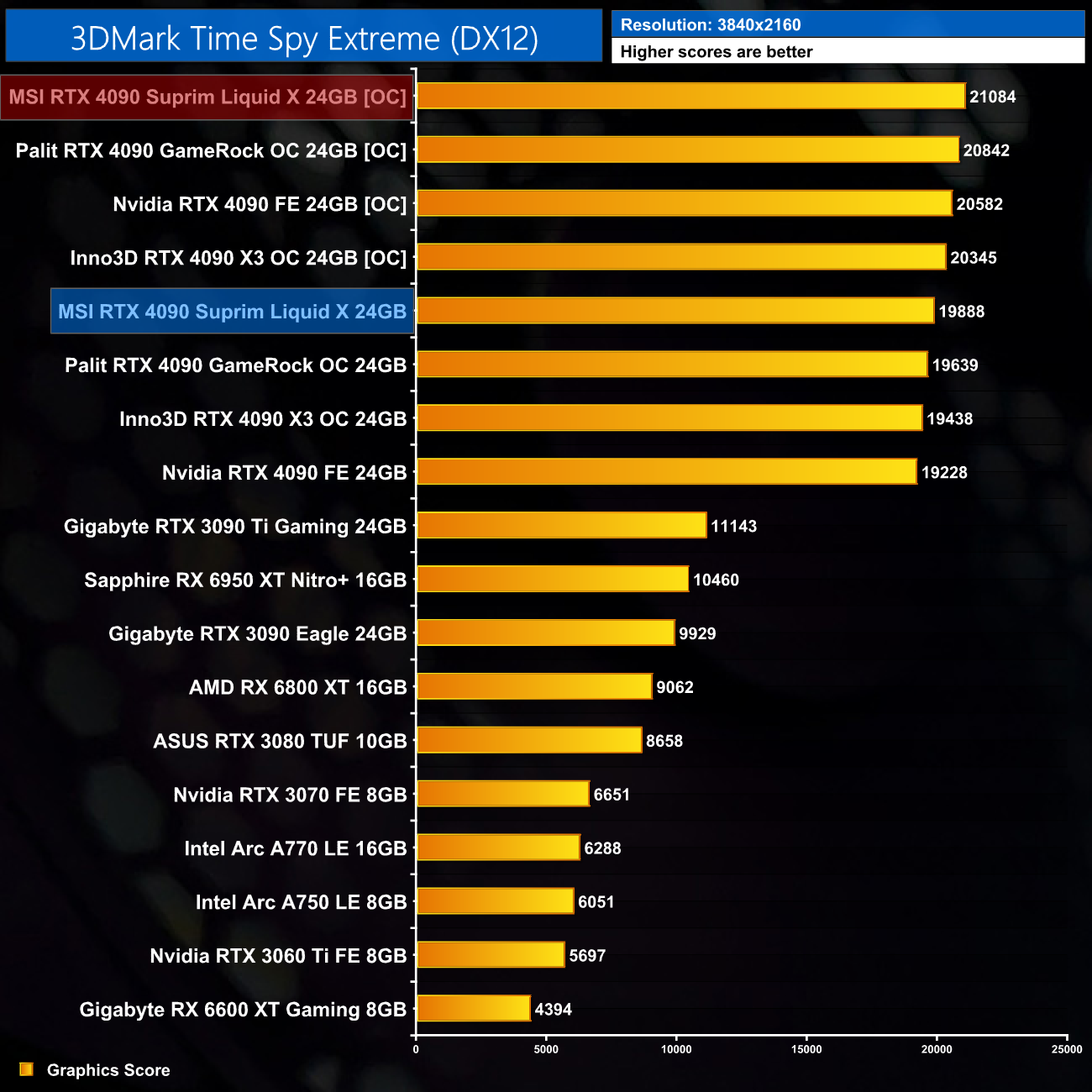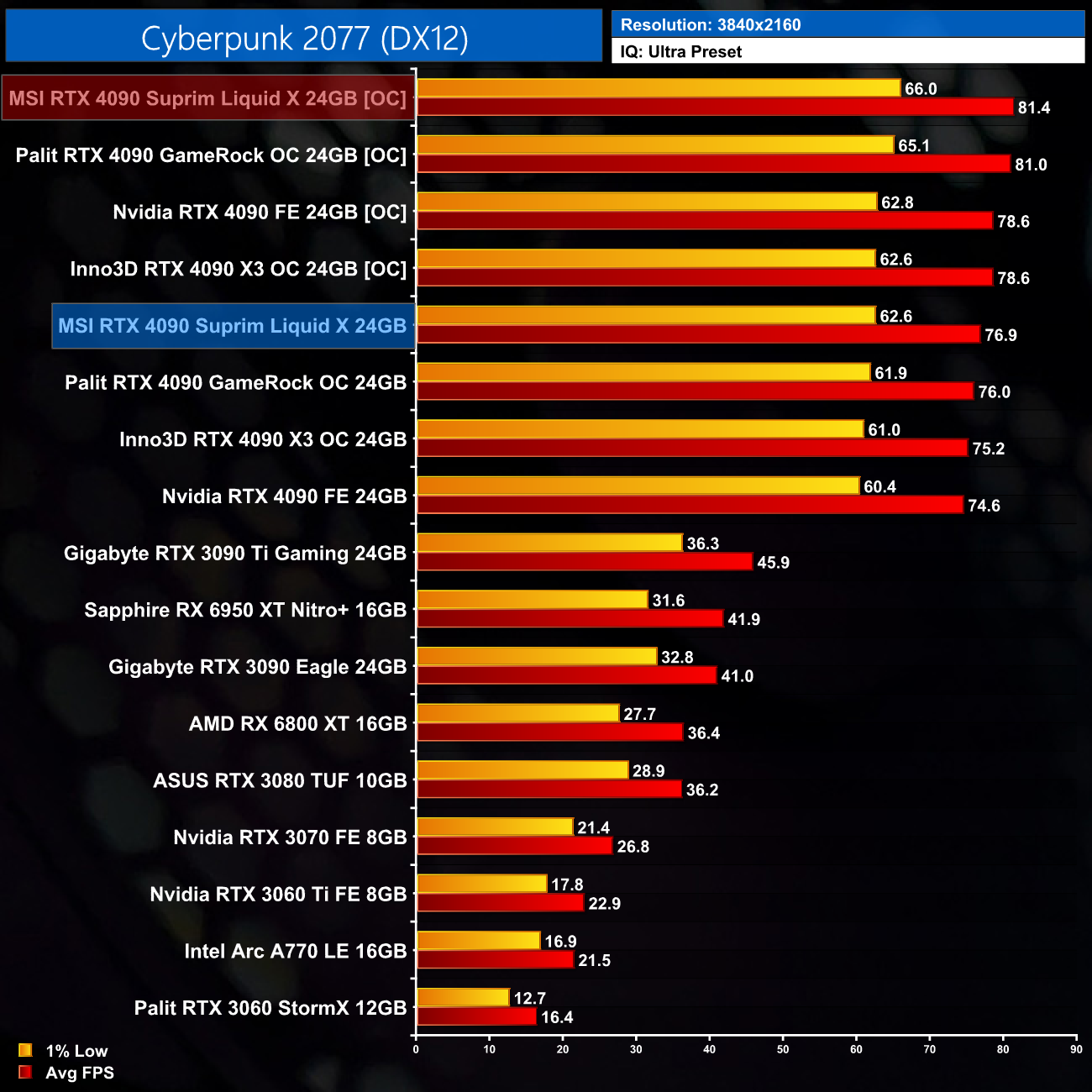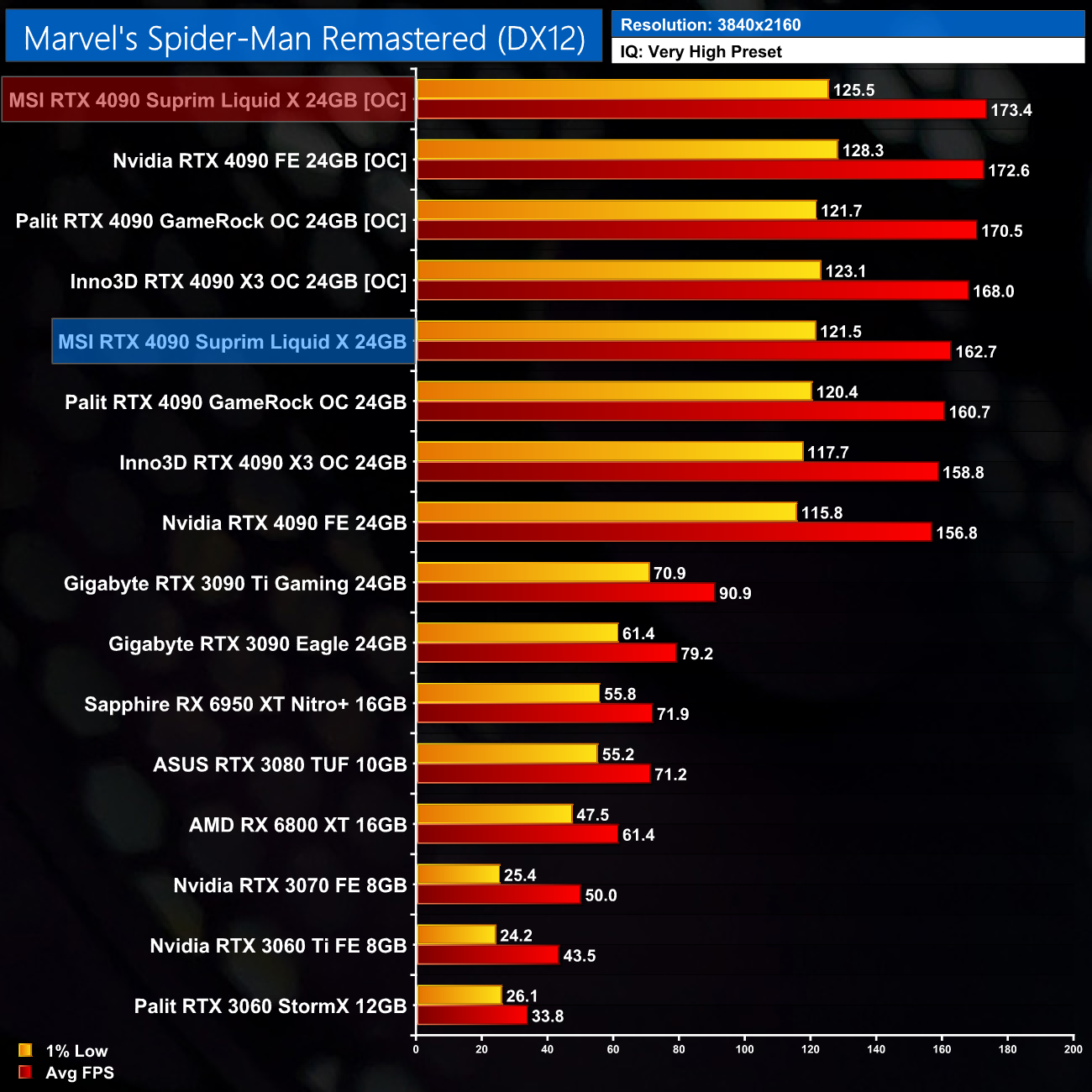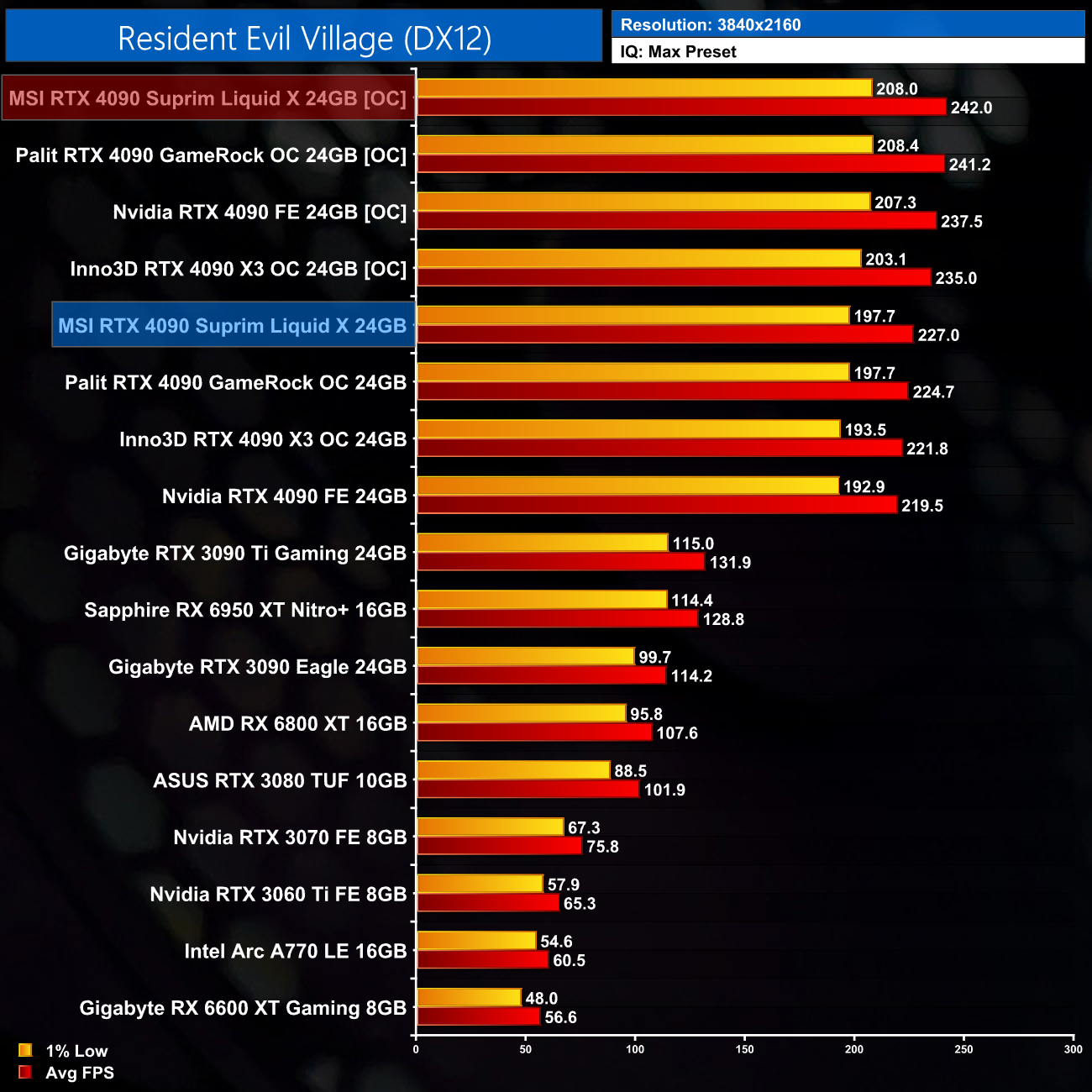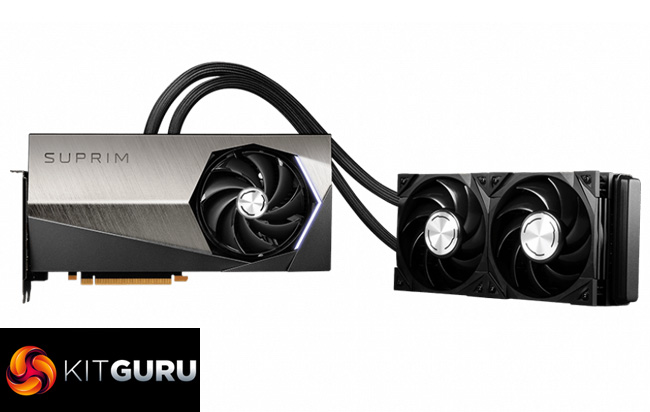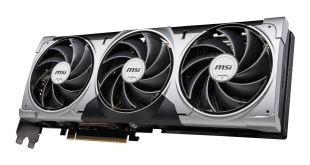
With graphics card power draw increasing generation-on-generation, Nvidia's flagship RTX 4090 can often pull more than 450W. That's a lot of heat to deal with, which is why the graphics cards themselves are bigger than ever. MSI, however, is taking a different approach with the Suprim Liquid X. The card itself is relatively compact as it makes use of a 240mm all-in-one liquid cooler. What benefit does this provide for thermals and noise levels? We find out today…
Alongside the 240mm AIO cooler, the MSI RTX 4090 Suprim Liquid X ticks a lot of boxes that we'd expect from a top-tier graphics card. A custom PCB design is used, dual-BIOS is present, there's an aggressive 105MHz factory overclock plus all the usual RGB bells and whistles.
There's no denying that such a bevy of features for a watercooled GPU comes at a price. Rather eye-wateringly, the Suprim Liquid X has an MSRP of £2179.99 here in the UK. Today we find out exactly what sort of performance is on offer for the money.
| RTX 4090 | RTX 3090 Ti | RTX 3090 | RTX 3080 Ti | RTX 3080 | |
| Process | TSMC 4N | Samsung 8N | Samsung 8N | Samsung 8N | Samsung 8N |
| SMs | 128 | 84 | 82 | 80 | 68 |
| CUDA Cores | 16384 | 10752 | 10496 | 10240 | 8704 |
| Tensor Cores | 512 | 336 | 328 | 320 | 272 |
| RT Cores | 128 | 84 | 82 | 80 | 68 |
| Texture Units | 512 | 336 | 328 | 320 | 272 |
| ROPs | 176 | 112 | 112 | 112 | 96 |
| GPU Boost Clock | 2520 MHz | 1860 MHz | 1695 MHz | 1665 MHz | 1710 MHz |
| Memory Data Rate | 21 Gbps | 21 Gbps | 19.5 Gbps | 19 Gbps | 19 Gbps |
| L2 Cache | 73729 KB | 6144 KB | 6144 KB | 6144 KB | 5120 KB |
| Total Video Memory | 24GB GDDR6X | 24GB GDDR6X | 24GB GDDR6X | 12GB GDDR6X | 10GB GDDR6X |
| Memory Interface | 384-bit | 384-bit | 384-bit | 384-bit | 320-bit |
| Memory Bandwidth | 1008 GB/Sec | 1008 GB/Sec | 936 GB/Sec | 912 GB/Sec | 760 GB/Sec |
| TGP | 450W | 450W | 350W | 350W | 320W |
First, for a quick spec recap. Using TSMC's 4nm node has allowed Nvidia to vastly increase transistor count, up from 28.3 billion with GA102, to a staggering 76.3 billion with the largest Ada GPU, AD102. Accordingly, core count has gone through the roof, with the RTX 4090 home to 16384 CUDA cores, with 512 Tensor cores and 128 RT cores, with a sizeable increase to the ROP count too, up to 176.
Such a leap forward in process node has also allowed Nvidia to crank the clock speed significantly, with the RTX 4090 now sporting a 2520MHz rated boost clock. The MSI Suprim Liquid X we are reviewing today has tweaked that further, adding an extra 105MHz out of the box.
Memory configuration is almost identical to the RTX 3090 Ti, with 24GB GDDR6X running at 21Gbps, operating over a 384-bit interface, totalling memory bandwidth of just over 1TB/s. That said, there has been a substantial upgrade to the L2 cache with the Ada architecture, with the RTX 4090 now offering 73MB, compared to 6MB for GA102.
Power draw also remains at 450W, as per the RTX 3090 Ti, though MSI has increased this further to 480W out of the box, and it can reach up to 530W when overclocking.
The MSI RTX 4090 Suprim Liquid X ships in a white box, with an image of the card and radiator visible on the front.
On the back of the box, MSI highlights various key features of the design, including the fan design, aluminium radiator and copper baseplate.
Inside, a Suprim Liquid X certificate is included, as well as a Suprim-branded mousepad that is in keeping with the card's overall design aesthetic. We also get a 4x 8-pin power adapter.
As for the graphics card itself, the first thing to note is MSI's hybrid cooling approach. The AIO cools the GPU and memory, but there is still a 100mm Torx 5.0 active fan built into the shroud to cool the VRM and the rest of the PCB.
Speaking of the shroud, MSI's Suprim line-up has always had quite a classy look and things are no different here, with a grey two-tone shroud. The shroud is made from plastic, but there's a brushed metal plate screwed on-top which helps give it a more premium look and feel.
It may sound strange but one of the benefits of opting for a watercooled card comes from the space savings. Of course, you will need to accommodate a 240mm radiator in your case, but which case can't fit at least a 240mm AIO?
The dimensions of the card itself however, are very compact by RTX 4090 standards, measuring in at 280 x 140 x 43 mm – so if your case can't accommodate a 30cm+ graphics card, or you need to access the third expansion slot, this could be an option.
In keeping with the shroud design, we also find a lovely two-tone metal backplate, complete with the Suprim hexagonal logo towards the end of the card.
Just next to the power connector is the dual-BIOS switch, with a choice between Gaming or Silent modes. The Gaming BIOS is the default and this offers a power limit of 480W, higher clocks and a more aggressive fan curve compared to the Silent mode, but we test both modes later in this review.
The power connector is of course the new 12VHPWR PCIe Gen5 connector, but, as noted above, an adapter is supplied. We can also see standard display outputs, with 3x DisplayPort 1.4 and 1x HDMI 2.1.
Looking at the radiator and AIO unit, this is manufactured by Cooler Master. The radiator measures 27mm thick, but as the fans are 27.5mm thick, you'll need about 56cmm clearance in your case. The sleeved tubing measures 47cm in length, which should be fine for all but the largest of chassis. As we note in the video however, the tubing exits straight out of the top of the card, adding an extra 4-5cm of effective height onto the card's 140mm tall shroud. Rotary right-angled fittings would have been a great move here, allowing the tubes to exit the card upwards and not outwards.
As for the two fans, these connect via standard 4-pin PWM headers to the small exposed wires. This is good news as the fans can be easily swapped out for third-party models with no proprietary headers to contend with. Just note that as MSI's included Silent Gale fans are slightly thicker at 27.5mm, using standard 25mm fans will require shorter screws to avoid puncturing the radiator fins. MSI says standard Asetek AIO screws will be fine, but these are not supplied in the box.
We discuss the ‘screw' situation in detail in the video, but it's worth highlighting a couple of strange design choices that MSI made. The first is the inclusion of just four shorter screws which would secure the radiator to your case. This is obviously just half the number of screw holes in the radiator itself, and while it would probably be secure enough with just four screws, is that really a risk you'd want to take with a £2000 RTX 4090? It just seems bonkers to me to only include half the number of screws when the cost would be pennies.
Secondly, due to both the length of the fan screws and the anti-vibration rubber mounts on the fans, I found that if you want to flip the fans over – either to have them in a pull configuration in the roof, or a push configuration in the front panel, with the fans on the inside of the chassis, the screws don't actually protrude through the fans enough to mount them to the radiator. If you put the fans outside the chassis, the screws protrude further, as they can sit flush against the fans. But with the fans on the inside of the case, the rubber mounts cause the screw holes to sit behind the radiator mounts by just a couple of millimetres, causing the problem just outlined.
The easy solution would be to include a second set of extra screws that are just a few mm longer – something Alphacool does with its radiators. To be clear, I don't think this is a huge issue and it may not even affect that many people, as the optimal configuration would be to have the radiator in the roof of the case, with the fans pushing air out. For a product of this price however, I would have thought that all eventualities would be covered, which is not the case.
Moving onto the PCB though, this is a custom design from MSI and it uses a monster 26-phase VRM for the GPU and a 4-phase VRM for the memory, controlled by the Monolithic Power Systems MP2891. 70A Monolithic MP86957 MOSFETs are used across the design.
As for the cooler, MSI is using a copper baseplate which contacts both the GPU and the VRAM, with the heat drawn away by the AIO cooler. The VRMs, however, make contact with the black secondary heatsink, which is cooled by the fan on the shroud itself. We can also see MSI is using thermal pads on the backplate, which will help draw out extra heat from the back of the memory modules and MOSFETs.
Driver Notes
- All AMD GPUs were benchmarked with the public Adrenalin 22.9.1 driver.
- All Nvidia GPUs (except RTX 4090) were benchmarked with the 516.94 driver.
- RTX 4090 was benchmarked with the 521.90 driver supplied to press.
- All Intel GPUs were benchmarked with the 101.3433 driver supplied to press.
Test System:
We test using a custom built system powered by MSI, based on Intel’s Alder Lake platform. You can read more about this system HERE and check out MSI on the CCL webstore HERE.
| CPU |
Intel Core i9-12900K
|
| Motherboard |
MSI MEG Z690 Unify
|
| Memory |
32GB (2x16GB) ADATA XPG Lancer DDR5 6000MHz
CL 40-40-40
|
| Graphics Card |
Varies
|
| SSD |
2TB MSI Spatium M480
|
| Chassis | MSI MPG Velox 100P Airflow |
| CPU Cooler |
MSI MEG CoreLiquid S360
|
| Power Supply |
Corsair 1200W HX Series Modular 80 Plus Platinum
|
| Operating System |
Windows 11 Pro 21H2
|
| Monitor |
MSI Optix MPG321UR-QD
|
| Resizable BAR |
Enabled for all supported GPUs
|
Comparison Graphics Cards List
- Sapphire RX 6950 XT Nitro+ 16GB
- AMD RX 6800 XT 16GB
- Gigabyte RX 6600 XT Gaming OC Pro 8GB
- Gigabyte RX 6600 Eagle 8GB
- Nvidia RTX 4090 Founders Edition 24GB
- Inno3D RTX 4090 X3 OC 2GB
- Palit RTX 4090 GameRock OC 24GB
- Gigabyte RTX 3090 Ti Gaming 24GB
- Gigabyte RTX 3090 Eagle 24GB
- ASUS RTX 3080 TUF Gaming 10GB
- Nvidia RTX 3070 FE 8GB
- Nvidia RTX 3060 Ti FE 8GB
- Palit RTX 3060 StormX 12GB
- Nvidia RTX 2060 FE 6GB
- Intel A770 Limited Edition 16GB
- Intel A750 Limited Edition 8GB
All cards were tested at reference specifications.
Software and Games List
- 3DMark Fire Strike & Fire Strike Ultra (DX11 Synthetic)
- 3DMark Time Spy (DX12 Synthetic)
- 3DMark DirectX Raytracing feature test (DXR Synthetic)
- Assassin's Creed Valhalla (DX12)
- Cyberpunk 2077 (DX12)
- Days Gone (DX11)
- Dying Light 2 (DX12)
- Far Cry 6 (DX12)
- Forza Horizon 5 (DX12)
- God of War (DX11)
- Horizon Zero Dawn (DX12)
- Marvel's Spider-Man Remastered (DX12)
- Metro Exodus Enhanced Edition (DXR)
- Red Dead Redemption 2 (DX12)
- Resident Evil Village (DX12)
- Total War: Warhammer III (DX11)
We run each benchmark/game three times, and present mean averages in our graphs. We use FrameView to measure average frame rates as well as 1% low values across our three runs.
3DMark Time Spy is a DirectX 12 benchmark test for Windows 10 gaming PCs. Time Spy is one of the first DirectX 12 apps to be built the right way from the ground up to fully realize the performance gains that the new API offers. With its pure DirectX 12 engine, which supports new API features like asynchronous compute, explicit multi-adapter, and multi-threading, Time Spy is the ideal test for benchmarking the latest graphics cards. (UL).
Early indicators from the Time Spy Extreme benchmark are positive – the Suprim Liquid X takes the top spot, delivering about 250 extra points versus the Palit GameRock OC.
Here we test five games, all at 3840×2160 resolution using maximum image quality settings.
Over the 5 games we tested, the Suprim Liquid X came in at most 4% faster than the Nvidia Founders Edition, but in other scenarios, it was just 2-3% ahead. We don't focus too much on game benchmarks for the AIB reviews, as practically speaking, the differences aren't noticeable when actually gaming.
Here we present the average clock speed for each graphics card while running Metro Exodus Enhanced Edition for 30 minutes. We use GPU-Z to record the GPU core frequency during gameplay. We calculate the average core frequency during the 30-minute run to present here.
Thanks to the Suprim Liquid X's increased power limit and 105MHz overclock, it does top the chart as the fastest-running RTX 4090 we have tested so far. Over our 30-minute stress test, it averaged 2820MHz using the Gaming BIOS, and 2760MHz using the Silent BIOS, so both results are clear of the next-fastest model, the Inno3D X3 OC.
For our temperature testing, we measure the peak GPU core temperature under load. A reading under load comes from running Metro Exodus Enhanced Edition for 30 minutes.
Looking at GPU thermals, here we are of course testing both the Gaming and the Silent BIOS modes. As expected, the Suprim Liquid X does deliver the best thermal results of any RTX 4090 so far, with the GPU hitting 60.3C using the Gaming BIOS, while it's about 3C warmer using the Silent BIOS.
There is, however, a slightly larger delta between the GPU and hot spot temperatures than we have come to expect, and the hot spot temperatures themselves aren't much if any better than the other cards we've tested. They're not bad by any stretch, but this sort of thing does make us wonder about either the flatness of the copper baseplate, or possibly the mounting pressure of the AIO onto the GPU die.
For our temperature testing, we measure the peak memory temperature under load. A reading under load comes from running Metro Exodus Enhanced Edition for 30 minutes.
In a similar fashion, GDDR6X thermals are definitely higher than what we'd expect, with the Silent BIOS hitting 82C, compared to 78C for the Gaming BIOS – making these results higher than both the Palit GameRock OC and the Inno3D X3 OC. We asked MSI about this and they told us our results are in-line with their internal figures, and it seems that the higher temperatures are a result of the AIO block not flowing liquid directly over the memory modules – rather, the memory contact zones actually raised slightly from the copper baseplate.
Again, to be clear these results are still perfectly fine and well within safe limits. For a liquid-cooled card however, we would have expected better.
We take our noise measurements with the sound meter positioned 1 foot from the graphics card. I measured the noise floor to be 32 dBA, thus anything above this level can be attributed to the graphics cards. The power supply is passive for the entire power output range we tested all graphics cards in, while all CPU and system fans were disabled. A reading under load comes from running Metro Exodus Enhanced Edition for 30 minutes.
Noise levels is an area where the Suprim Liquid X does well. Using the Gaming BIOS, we saw noise levels hit 37dBa, and this dropped 2dBa using the Silent BIOS as that has a more relaxed fan curve, for both the radiator fans and the fan on the card itself, so this is definitely a key benefit to the AIO approach.
That said, I did notice a bit of coil whine when gaming, it was nothing terrible but we include a sound test in the video. The whine was also exacerbated with the card overclocked, so just something to keep in mind.
Following on from our stock thermal and acoustic testing, here we re-test the operating temperature of the GPU, but with noise levels normalised to 40dBa. This allows us to measure the efficiency of the overall cooling solution as varying noise levels as a result of more aggressive fan curves are no longer a factor.
Raising fan speeds to hit 40dBa, we can see noise-normalised GPU temperatures are the best yet, with the Suprim Liquid X keeping the GPU about 5C cooler than the Palit GameRock OC. The hot spot temperature is still running a bit hotter however, coming in just shy of 70C.
Likewise for the memory modules, a noise-normalised result of 74C makes this warmer than both air-cooled AIB cards we've tested, though it is still an improvement on the Founders.
For a quick look at total system power draw, we can see the Suprim Liquid X drawing a bit more than the competition due to the 480W power limit. It’s hardly a big difference, and the Silent BIOS does actually reduce the power limit back to 450W.
For our manual overclocking tests, we used MSI Afterburner. Our best results are as below.
With the Suprim Liquid X, the power limit can be increased up to a maximum of 530W. We added 180MHz to the GPU and 1650MHz to the memory.
In the titles we re-rested, this overclock netted an extra 6-7% performance versus stock. It’s fine overall and exactly what we have come to expect from the RTX 4090.
The MSI RTX 4090 Suprim Liquid X is the fourth RTX 4090 card we've tested, but the first one to ship with a hybrid cooler approach, using a 240mm AIO to tame the GPU and memory, while an active fan in the shroud deals with the power delivery components.
While that primarily allows the Suprim Liquid X to run quiet and cool, the factory overclock and increased thermal headroom also makes this the fastest RTX 4090 we have tested to date. Not by much, though it is on average 3% faster than the Founders Edition. We don't place too much emphasis on this metric as you simply wouldn't be able to tell the difference in the real world, but it's good to know this RTX 4090 performs as expected.
Of course, thermals are of key interest, and out of the box we noted the Gaming BIOS running about 5C cooler than the next-best partner card, Inno3D's X3 OC. There is, however, a slightly larger delta between the GPU and the hot spot temperature than what we have come to expect, with the hot spot temperature running a touch warmer than the X3 OC, possibly indicating that the coldplate flatness or mounting pressure could be improved. It's not a major concern, but it is something we noticed.
Likewise, the memory thermals also run hotter than both the X3 OC and the Palit GameRock OC. The AIO itself does cool the memory modules, but they contact with a slightly raised section of the copper coldplate which isn't directly mounted to the AIO, resulting in the higher temperatures we saw today versus the air-cooled cards which use large vapour chambers to contact the memory. The temperatures are still well within safe limits, but we would have hoped for better results.
Other benefits of the watercooled approach include the fact that the card itself is relatively compact. Most cases on the market will accommodate a 240mm radiator, but if you don't want to lose an expansion slot with a triple-slot cooler, or perhaps your case can't fit cards that are 30cm+, then this could be an appealing option.
We did note a bit of a ‘screw situation' though, indicating fairly poor attention to detail on MSI's part. For one, only four radiator screws – instead of eight – are provided, which is quite baffling to me for a £2000+ graphics card. Additionally, if you want to flip the fans to the other side of the radiator and secure the unit that way, the fan screws aren’t even long enough to screw into the radiator due to the anti-vibration rubber pads causing the screw holes to sit back from the radiator mounting holes.
None of those issues are deal-breakers, and if you are in the US market where the Suprim Liquid X costs $1749.99 – just a 9% premium over the baseline MSRP – then they could well be forgiven. For UK buyers however, we were told the MSRP is set at £2179.99 – a 26% premium over the baseline MSRP. I understand the pound is fairly weak against the dollar, but even taking that and 20% VAT into account, we are clearly getting the short end of the stick this side of the Atlantic.
Ultimately, while there is a lot to like about the MSI RTX 4090 Suprim Liquid X, there are just a few too many question marks around the design to give it a wholehearted recommendation, something which is only exacerbated due to the very steep price – even by RTX 4090 standards.
We found the card listed on Overclockers UK HERE, though it is currently out of stock.
Discuss on our Facebook page HERE.
Pros
- Low GPU temperatures.
- The card itself is a compact dual-slot design (just be sure you can fit a 240mm radiator.)
- Sleek aesthetic.
- Fans run nice and quiet.
- 4-pin PWM fans are used and can be swapped for third-party models.
Cons
- Memory runs hotter than the air-cooled AIB cards we've tested.
- Larger than expected delta between GPU and hot spot temperatures.
- Some coil whine was audible.
- Not enough radiator screws included.
- Included fan screws don't allow for certain mounting configurations.
- UK buyers are getting a very poor deal compared to the US.
KitGuru says: The MSI RTX 4090 Suprim Liquid X does a few things very well indeed, but it also left me scratching my head on a number of occasions.
 KitGuru KitGuru.net – Tech News | Hardware News | Hardware Reviews | IOS | Mobile | Gaming | Graphics Cards
KitGuru KitGuru.net – Tech News | Hardware News | Hardware Reviews | IOS | Mobile | Gaming | Graphics Cards


